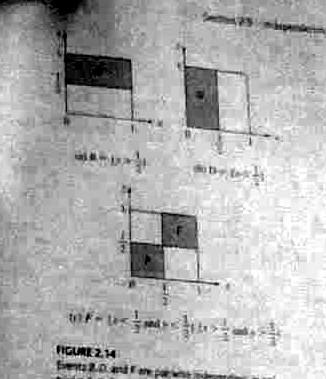Engineering Probability Class 5 Thu 2020-01-30
Table of contents::
1 Probability in the real world - enrichment
See examples in the random section below.
2 Homework 3
is online here , due in a week.
3 Chapter 2 ctd
- Example 2.28, p51. Chip quality control.
- Each chip is either good or bad.
- P[good]=(1-p), P[bad]=p.
- If the chip is good: P[still alive at t] = \(e^{-at}\)
- If the chip is bad: P[still alive at t] = \(e^{-1000at}\)
- What's the probability that a random chip is still alive at t?
- 2.4.1, p52. Bayes' rule. This lets you invert the conditional probabilities.
-
\(B_j\) partition S. That means that
- If \(i\ne j\) then \(B_i\cap B_j=\emptyset\) and
- \(\bigcup_i B_i = S\)
- \(P[B_j|A] = \frac{B_j\cap A}{P[A]}\) \(= \frac{P[A|B_j] P[B_j]}{\sum_k P[A|B_k] P[B_k]}\)
- application:
- We have a priori probs \(P[B_j]\)
- Event A occurs. Knowing that A has happened gives us info that changes the probs.
- Compute a posteriori probs \(P[B_j|A]\)
-
\(B_j\) partition S. That means that
- In the above diagram, what's the probability that an undergrad is an engineer?
- Example 2.29 comm channel: If receiver sees 1, which input was more probable? (You hope the answer is 1.)
- Example 2.30 chip quality control: For example 2.28, how long do we have to burn in chips so that the survivors have a 99% probability of being good? p=0.1, a=1/20000.
- Example:
False positives in a medical test
- T = test for disease was positive; T' = .. negative
- D = you have disease; D' = .. don't ..
- P[T|D] = .99, P[T' | D'] = .95, P[D] = 0.001
- P[D' | T] (false positive) = 0.98 !!!
4 Bayes theorem ctd
-
We'll do the examples.
-
We'll do these examples from Leon-Garcia in class.
-
Example 2.28, page 51. I'll use e=0.1.
Variant: Assume that P[A0]=.9. Redo the example.
-
Example 2.30, page 53, chip quality control: For example 2.28, how long do we have to burn in chips so that the survivors have a 99% probability of being good? p=0.1, a=1/20000.
-
Event A is that a random person has a lycanthopy gene. Assume P(A) = .01.
Genes-R-Us has a DNA test for this. B is the event of a positive test. There are false positives and false negatives each w.p. (with probability) 0.1. That is, P(B|A') = P(B' | A) = 0.1
- What's P(A')?
- What's P(A and B)?
- What's P(A' and B)?
- What's P(B)?
- You test positive. What's the probability you're really positive, P(A|B)?
5 Chapter 2 ctd: Independent events
-
2.5 Independent events
- \(P[A\cap B] = P[A] P[B]\)
- P[A|B] = P[A], P[B|A] = P[B]
-
A,B independent means that knowing A doesn't help you with B.
-
Mutually exclusive events w.p.>0 must be dependent.
-
Example 2.33, page 56.

-
More that 2 events:
- N events are independent iff the occurrence of no combo of the events affects another event.
- Each pair is independent.
- Also need \(P[A\cap B\cap C] = P[A] P[B] P[C]\)
- This is not intuitive A, B, and C might be pairwise independent, but, as a group of 3, are dependent.
- See example 2.32, page 55. A: x>1/2. B: y>1/2. C: x>y
-
Common application: independence of experiments in a sequence.
-
Example 2.34: coin tosses are assumed to be independent of each other.
P[HHT] = P[1st coin is H] P[2nd is H] P[3rd is T].
-
Example 2.35, page 58. System reliability
- Controller and 3 peripherals.
- System is up iff controller and at least 2 peripherals are up.
- Add a 2nd controller.
-
2.6 p59 Sequential experiments: maybe independent
-
2.6.1 Sequences of independent experiments
- Example 2.36
-
2.6.2 Binomial probability
- Bernoulli trial flip a possibly unfair coin once. p is probability of head.
- (Bernoulli did stats, econ, physics, ... in 18th century.)
-
Example 2.37
- P[TTH] = \((1-p)^2 p\)
- P[1 head] = \(3 (1-p)^2 p\)
-
Probability of exactly k successes = \(p_n(k) = {n \choose k} p^k (1-p)^{n-k}\)
-
\(\sum_{k=0}^n p_n(k) = 1\)
-
Example 2.38
-
Can avoid computing n! by computing \(p_n(k)\) recursively, or by using approximation. Also, in C++, using double instead of float helps. (Almost always you should use double instead of float. It's the same speed.)
-
Example 2.39
-
Example 2.40 Error correction coding